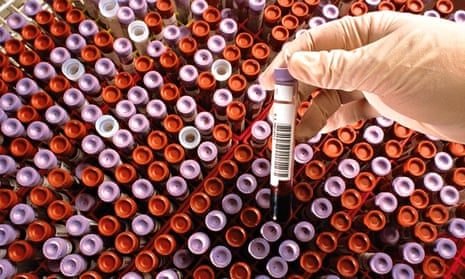A recent black-and-white documentary, Blood, about a mobile blood collection unit in rural Russia, shows scenes familiar to many: dusty halls, anxious donors queuing to register, the occasional struggle to find a vein. Cups of tea, too, albeit just for the team.
Then there are the differences. Donors sit upright on uncomfortable, hard chairs. Some have just come off night shift; others have no money for food. Staff are concerned about how many units will test positive for blood-borne viruses. Potential donors worry about being accepted. A woman without an up-to-date residency certificate is turned away. A man insists he should be allowed to donate; he is broke and desperate for the 850 roubles (£8.85) payment. It is clear that most donors come for the money: for some, it is a lifeline.
Russia isn’t alone in paying donors – the US, China and Germany do, too. In Britain, however, we donate 2m units a year, with no payment – following the World Health Organisation recommendation that blood donation be voluntary. This is not only for altruistic reasons, but also for safety. “The safest blood donors are voluntary, non-remunerated donors from low-risk populations,” says the WHO.
It may even be counterintuitive to offer financial reward – a study in New Zealand showed that offering payment would put off some donors. Meanwhile, voluntary UK donors might want reassurance that their blood is not sold for commercial gain: it isn’t; their donations are separated into red cells and platelets, which are supplied to UK hospitals at cost price, and the NHS is self-sufficient in these products.
Nevertheless, thousands of NHS patients receive blood plasma from paid donors. This contains clotting factors and antibodies. Thousands of individual donations go into each dose of clotting factors – used to treat haemophiliacs who are bleeding – or immunoglobulins (antibodies) used to treat people with autoimmune diseases, severely damaged immune systems, or some serious infections.
After the outbreak of bovine spongiform encephalopathy (BSE), known as mad cow disease, some recipients of UK plasma products developed the fatal brain disease variant Creutzfeldt-Jakob-disease (vCJD). As there is as yet no adequate screening test for this, British plasma has not been used since 2002, when we began to import it from the US.
Receiving donated blood has always carried risk. Early transfusions, direct from donor to patient, were fraught with problems. Later, anticoagulation using citrate reduced the risk of clotting and made possible transfusion on the battlefields of the first world war. Incompatibility was still a hazard, but when better cross-matching and screening became routine, the risks were all but forgotten – until 1983, when the risk of HIV through donated blood was recognised, after the deaths of haemophiliacs in the US.
Blood-borne infections are still a growing threat. In our overcrowded global community, new diseases – such as Ebola – emerge and spread rapidly. The plasma trade is global, with companies exporting worldwide. Currently, all products used in the UK come from safe sources, but with plasma in increasingly short supply, we may have to choose between denying patients plasma-based treatments, or buying them from more risky sources.
Few countries that pay for donation maintain the high standards of screening needed for patient safely. Even if testing kits are available and used, turning blood into a commodity opens the door to commercial pressures: donors are dishonest about their risk factors, companies turn a blind eye and cut corners. If you are on skid row, plasma donation is a good way to pay for your next fix, and companies keen to exploit worldwide demand may not be too assiduous in checking the honesty of potential donors, or in screening them.
If receiving a unit of red cells – particularly from a questionable source – is risky, then plasma products are far more so. Plasma proteins are extracted from circulating blood by a process called plasmapheresis: the plasma is siphoned off and the blood cells are returned to the donor. Donors can give plasma every few days, so it can be a regular earner.
In the US, the business has a long history of scandals. For years, prisoners in Arkansas donated plasma and recipients developed the blood-borne infections it contained. Despite revelations of poor screening, companies continued to buy plasma taken from prisoners until 1994. China, too, has an appalling record. A Chinese company running an illegal collection passed inspections by the authorities, but in 2006 was shown to be selling plasma infected with hepatitis C. Britain can’t claim an unblemished record, either – from the 1970s to the early 1990s, thousands of people given NHS blood products developed HIV and/or hepatitis C.
We now import our plasma via a government-owned company. But in 2013, the government sold an 80% share of the business to Bain Capital, a US venture capital group. Though there is no reason to doubt the quality of plasma supplied, many feel uncomfortable about introducing the profit motive to the supply of blood products.
Over the past few years, the Medical Research Council has been developing a highly sensitive blood test for vCJD. If it proves adequate for screening donated blood, we will be able to decrease our dependency on imported plasma, but we still won’t be self-sufficient. We might be able to supply enough intravenous immunoglobulin (IVIG) for standard treatments, but 85% of IVIG uses are for conditions for which it is not yet licensed. IVIG is a “wonder drug” that is being tried for everything from cancer to obsessive compulsive disorder in children, while immunoglobulin from the plasma of Ebola survivors is being trialled as a treatment for Ebola. Worldwide demand is outstripping supply, and the pressures on producers to exploit donors and cut corners will increase – and so will the risks.

Comments (…)
Sign in or create your Guardian account to join the discussion